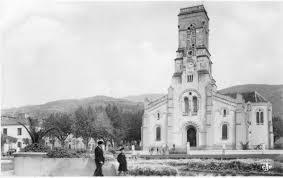Saint-Charles Church: The Center Church

The Saint-Charles church , once a significant Catholic landmark in Blida, reflects a layered history—spanning from humble beginnings in repurposed mosques to its 19th-century formal construction, decoration, and eventual demolition in the 1970s.
Early Worship and Founding
- Before a proper church existed, Catholic worship in Blida was held in a makeshift wooden structure. This was erected soon after 1830, on the site of modern-day Galeries de France and Boulevard Trumelet .
- On 4 November 1840, the Grand Mosque of Blida (Djemaà el Kébir) was converted into a parish church. It was dedicated to Saint Charles Borromée and consecrated by Bishop Dupuch of Algiers, in the presence of military leadership .
- The church was officially consecrated again on 4 November 1842. Bishop de Mazenod of Marseille led the ceremony, with other bishops joining in liturgical concurrence after the first phase of establishment .
Construction of the Saint-Charles Church
- On 20 June 1860, Blida’s municipal council, led by Mayor Lemoine, decided to construct a new church—planned in a Romanesque style meant to make a dignified civic statement (Blidanostalgie, Les 4 éléments).
- This new Église Saint-Charles was completed and decorated by spring 1863 .
- The stone church was eventually consecrated in October 1864, marking a formal emergence for the parish within the city’s urban fabric (Blidanostalgie, Les 4 éléments).
Clergy, Community, and Ceremonies
- In November 1901, Bishop Henry of Grenoble, born in Blida, returned to consecrate the main altar. Mass was celebrated with strong participation. Veterans, charitable groups, and local residents all attended the ceremony, showing civic devotion.
- In 1924, the church saw important enhancements, including new organ pipes. This reflected a growing and active parish life. Music filled the hall and brought the community together in worship and celebration.
- In 1948, the church’s bells were updated, replacing the older ones from the 19th century. The three new bells were named Charles-Augustin, Anne, and Jeanne, marking another key moment in its history.
Demise and Replacement
- Despite its long service, the Église Saint-Charles was completely demolished between 1974 and 1975 (alger-roi.fr, Les 4 éléments).
- Today, the former site is occupied by the Mosquée El-Kawthar, which stands where the church once did (Wikimapia).
Summary Timeline
| Year / Date | Event |
| c.1830s | Catholic worship held in wooden structure post-conquest |
| 4 Nov 1840 | Mosque converted and consecrated as Church of Saint Charles |
| 4 Nov 1842 | Official consecration by Bishop de Mazenod of Marseille |
| 20 Jun 1860 | Municipal decision to build a new stone church |
| Spring 1863 | Construction and decoration completed |
| Oct 1864 | Formal consecration of the finished church |
| Nov 1901 | Bishop Henry consecrated the main altar |
| 1924 | New organ installed |
| 1948 | New bells Charles-Augustin, Anne, Jeanne installed |
| 1974–75 | Church demolished |
| Present | Site occupied by Mosquée El-Kawthar |
Significance of saint charles church
Saint-Charles Church served as a spiritual anchor for Blida’s Catholic community for over a century. Its story illustrates the city’s colonial-era religious dynamics and evolving urban identity—from Islamic to Catholic places of worship, and then replacement by another religious institution. The church’s ceremonies, architecture, and eventual removal reflect broader societal shifts through the 19th and 20th centuries.